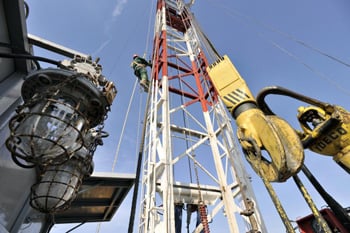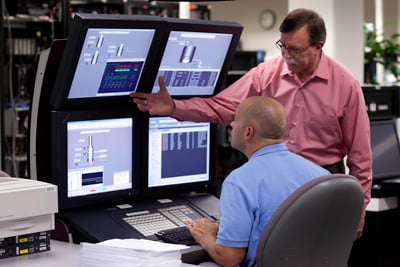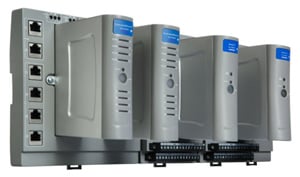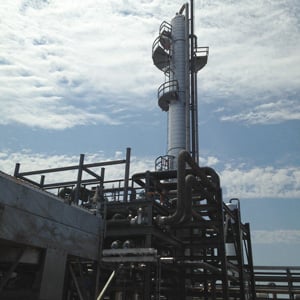This post was authored by Randy Miller of Honeywell Process Solutions.
Global trends in the demand and supply of energy require constant improvement of technologies and services, exploration, and production. In this environment, shale gas has emerged as a key unconventional resource. With current operating challenges, the shale gas industry requires access to real-time data and improved process control capabilities to continually optimize the performance of wells with rapidly changing production profiles, particularly as reduced drilling activity increases production variability across assets.
This post describes a holistic, integrated approach to address operational efficiencies and manage capital expenditures for shale gas producers, encompassing gas production, processing, and automation. This approach drives greater agility, enabling operators to adapt to business conditions quickly and cost effectively, to help ensure profitability in uncertain times.
Growing importance of shale
Increased production of natural gas in North America in recent years has been attributed, in large part, to the development of shale gas resources. This type of unconventional natural gas is trapped in a free or adsorbed state in shale or mudstone formations, which are mainly composed of methane. The production of natural gas from shale formations is one of the fastest-growing segments of the global oil and gas sector.
In addition to North America, shale gas sources have been identified in China, Argentina, South Africa, Australia, and throughout Europe. According to the U.S. Energy Information Administration’s Annual Energy Outlook 2012, shale gas production will increase from 5.0 trillion cubic feet per year (23 percent of total U.S. dry gas production) in 2010 to 13.6 trillion cubic feet per year (49 percent of the total) in 2035. Shale gas production is very process intensive, with many applications in extraction, separation, treatment, environmental monitoring, and distribution requiring effective process control technologies.
Exploration and production (E&P) companies are investing considerable resources in not only developing well pads, but also in equipping each producing pad and building with gathering systems and installing centralized facilities to accommodate production streams, which are often multiphase with varying combinations of gas and liquids. The complexity of liquids-rich shale assets can be problematic throughout all stages of field development, including well planning and construction, facilities deployment, and operations.
Furthermore, accelerated production decline and a tightening regulatory environment leave little margin for error. New, permanent demand for shale gas is emerging in residential heating (from heating oil), ethylene and basic chemicals manufacturing, and liquefied natural gas international exports. These new opportunities are changing the landscape of gas from regional to global, adding new complexities to the value chain.
Increased operational demands
Owner-operators and independent E&P companies require effective strategies to deal with this increasing complexity, including difficult operational, environmental, and regulatory demands, as they strive to refine hydrocarbon products safely, efficiently, and profitably. The recent phenomenon of falling oil prices only complicates this situation. The key challenges facing shale gas producers relate to the safety, reliability, efficiency, and flexibility of their operations. For instance, there is a crucial need to improve safety by reducing and mitigating incidents.
Operators must also comply with critical infrastructure protection regulations while reducing human error, improving emergency response, and minimizing liability. From a reliability standpoint, they need to improve asset availability, and at the same time, protect high capital cost equipment, enhance production facilities and field life, and extend overall investments.
The demand for greater efficiency includes reductions in operating costs and energy consumption, along with increased production rates. Operators also require increased agility to exploit regional dynamics and opportunities, as well as anticipate and manage changes in composition and volumes. Finally, they must adapt to changing regulatory requirements and reduce risk in volatile operating environments.
 Key challenges facing shale gas producers relate to the safety, reliability, efficiency, and flexibility of their operations.
Key challenges facing shale gas producers relate to the safety, reliability, efficiency, and flexibility of their operations.
To boost profits, shale gas producers want to maximize ultimate product recovery while lowering capital expenditures and operating expenses—no easy task, as it often entails increasing energy efficiency, reducing reactive maintenance, extending asset life, and eliminating unplanned downtime. This effort encompasses everything from process optimization to operator training and effectiveness.
There is also an urgent need for reliable remote operations capabilities in almost all areas of the oil and gas field. Distributed assets can include multiple pods of local control, which must be unified and operated as a cohesive asset. Traditionally, these local pods of control were managed by legacy automation with stand-alone local databases—all with their own life-cycle management, maintenance requirements, and high failure rates. Shortages of qualified staff, brought about by the departure of retirement-age workers, affect shale operators’ ability to capitalize on emerging technologies. Without appropriately skilled personnel, producers cannot always meet the demand that exists.
Although some operating companies are taking advantage of leading-edge control and automation technologies, much of the industry still uses fairly rudimentary controls—focused primarily on safety and uptime—with little in the way of yield and throughput optimization. Many companies have grown weary of the time and effort required to manage applications—many of which are homegrown.
They want to work with a vendor that has the expertise to manage the life cycle of infrastructure and applications, freeing the operators to focus their attention on production. Engineering, procurement, and construction firms serving the shale industry cope with a different set of challenges: Multiple supplier bid packages must be integrated into a single, seamless system to manage operations. This scenario presents problems associated with product maturity, obsolescence, mismatched communication protocols, incompatible operating systems, etc.
Managing disparate assets over their entire lifetime can be bothersome, to say the least. With the rapid pace of shale play development in recent years, companies often delayed automation investments. Operators devoted their resources to bringing new oil and gas reserves to customers. Automation upgrades fell behind the curve, and control system projects were held off the critical path—even if they could contribute to improved production capabilities and human capital efficiency.
Today, shale operators are striving for an entirely new approach to automation to deal with low prices, fast production drop-off, constrained capital expenditures (CAPEX), and a proliferation of isolated wells. With fewer formalized automation departments, nagging capacity issues, and a squeeze on capital projects, they are searching for an operating expense-driven approach that allows flexibility in future technology adoption.
 Incorporating process and operating knowledge into advanced control and automation solutions helps shale producers achieve operational excellence.
Incorporating process and operating knowledge into advanced control and automation solutions helps shale producers achieve operational excellence.
Holistic approach to technology
Now, more than ever, shale gas producers need to partner with solution providers to ensure they can monetize their resources in a timely, capital-efficient manner. Success often hinges on executing gas projects quickly at reduced cost compared to traditional methods, as well as making sure projects can maximize the recovery of high-value products at low production cost and downtime.
From an operational perspective, reservoir operators want to use their assets more effectively and manage production better. Due to the current slowdown in well completion, they have more time to consider the return on capital that automation can deliver. Major suppliers to the oil and gas industry have taken steps to incorporate process and operating knowledge into advanced control and automation solutions to help shale producers achieve operational excellence. Integrated automation with gas processing equipment can significantly reduce the impact of bottlenecks in the gas value chain by compressing schedules up to 30 percent and reducing commissioning time with versatile, integrated modular solutions.
Flexible universal automation also allows companies to make changes programmatically, rather than by the traditional rework to physical cabinets and field wiring, leading to faster startups. An integrated approach to automation enables operators to remotely monitor the entire shale gas production process from collection to distribution through distributed control and centralized management. At the same time, it helps them keep track of equipment operation to guarantee safe and reliable production. Users can closely analyze processes and make improvements that will maximize on-stream performance and business results. Remote operations monitoring tools validate and transform raw data into actionable information.
Operators can react quickly to ever-changing conditions across production assets using standardized calculations for maximum efficiency. The latest technology advancements for shale gas production range from modern distributed control systems (DCSs)—which enable E&P firms to more tightly control their processes and produce oil and gas in greater volumes than ever before—to advanced process control and optimization applications that increase throughput and yields of unconventional gas facilities, to unified solutions for fire and gas, incorporating gas detectors, fire detectors, fire alarm panels, safety integrity level 3-certified programmable logic controllers, and an integrated fire and gas safety system. In addition, the current breed of smart field devices supports instrument asset management strategies via industry-standard protocols such as HART, Profibus, and FOUNDATION Fieldbus.
 Technology innovations, such as a new generation of RTUs, enable greater connectivity and data integration across the enterprise.
Technology innovations, such as a new generation of RTUs, enable greater connectivity and data integration across the enterprise.
Technology innovations also enable greater connectivity and data integration across the enterprise. For example, a new generation of remote terminal units (RTUs), featuring native redundancy, expanded I/O modules, and wireless I/O, have more communication flexibility and provide visibility into efficient utilization of distributed assets through expanded remote monitoring, diagnostics, and asset management. They are designed for companies to deploy at remote sites with very low power consumption and may use solar power.
As a result, operators can perform remote maintenance and dramatically cut equipment monitoring and diagnostic time. Combining the new RTUs with an enhanced supervisory control and data acquisition (SCADA) platform further helps operators realize the production potential of their distributed assets. This approach simplifies configuration over thousands of assets and improves operational efficiency with a better human-machine interface. It serves as an integration backbone across the gas value chain, allowing multiple SCADA servers to operate as one within a single asset or across the enterprise. Applications that are native to the SCADA platform complete the operations integration, including the management of safety, asset integrity, and product movement both upstream and downstream.
Leading automation suppliers have responded to the need for project optimization with innovative, enabling technologies like virtualization, universal I/O, and cloud engineering. These solutions help operators do away with traditional task dependencies and sequential work processes, drastically improving the overall project schedule and keeping control systems off the critical path. Revised project methodologies rely on separating physical from functional design, using standardized designs, and enabling engineering to be done from anywhere in the world.
To support integration across their value chain, shale gas operations can leverage methodologies unifying state-of-the-art process and automation technologies. Innovative gas treatment, purification, and processing techniques help optimize the development of unconventional, remote, and subquality gas resources, which are vital contributions to the world’s gas supply. Using the latest sophisticated techniques, operators can remove impurities from gas so it can be transported by pipeline, as well as recover valuable condensate and natural gas liquids, such as ethane, propane, and butane. Shale developments typically come online incrementally and have strict capital efficiency requirements.
As such, they benefit from pre-engineered, factory-built modular plants that provide flexibility for changing feed and product requirements. With modular plants, companies can deliver and install liquid gas recovery units faster than with stick-built alternatives. Plant fabrication can occur in tandem with drilling, fracturing, and well testing. For operators developing new resources, these new capabilities to parallel the field and plant development processes are essential to bringing on new assets quickly.
They also provide a rapid return on the large capital outlays required to meet growing shale development. Implementing modular plant techniques, coupled with pre-existing and standardized automation designs, operator displays, etc., helps “de-risk” projects and reduce the time to commercial startup. Site acceptance tests can be performed more smoothly on proven standard units, and users realize the value of embedded process expertise in their plant automation system in the form of procedural operations, advanced control strategies, and operator training and simulation. By employing modular design and construction, equipment can be easily shipped to remote locations where gas is often discovered. This allows operators to begin processing gas and earning revenue more quickly. Common parts, which simplify maintenance and training, also bring greater ease of operations.
Benefits to gas producers
With the uncertainty of global energy demand, shale gas producers must take an objective look at their production operations to make efficiency improvements and eliminate unplanned production downtime. Those firms applying a successful automation strategy that allows them to enhance the safety, reliability, efficiency, and flexibility of their operations will be in an even stronger position when demand recovers.
With tight integration of all key aspects of production, processing, and transportation, operators can compete more effectively under the toughest economic conditions. This approach addresses fragmentation across the gas value chain, closes gaps created by interfaces between different operating companies, brings together a wide range of “best-of-breed” point solutions, and unifies control schemes with the DCS to enable operational excellence at startup and beyond. The typical results of a holistic strategy for gas industry projects include:
- compressed schedule and faster startups
- reduction of automation change orders
- increased process efficiency
- improved operational reliability
- enhanced asset integrity
- stabilization of production
- enablement of smoother startup
- elimination of operator errors
- reduced cost and risk
- improved plant safety
- maintaining physical security and cybersecurity
- protecting equipment, the environment, and workers
- optimized knowledge transfer
- improved product quality
With real-time automation and communications, companies can monitor, control, and enhance production operations through smarter networks that can be accessed anytime and anywhere using smartphones, tablets, and personal computers. Indeed, wireless communications give operators the reliable, real-time information needed for optimizing production.
The increasing use of modular equipment reduces field construction time and lowers capital and operating costs for shale gas operators, and allows them to achieve aggressive schedules to first gas, which can generate significant incremental value. Modular, prefabricated solutions enable economic development of shale gas resources that would otherwise be daunting processing challenges given their inherent variability in gas composition.
 Shale developments benefit from pre-engineered, factory-built modular plants that accommodate changing feed and product requirements.
Shale developments benefit from pre-engineered, factory-built modular plants that accommodate changing feed and product requirements.
Ultimately, an integrated approach to gas industry projects overcomes the inherent drawbacks of consolidating a host of third-party vendors and technologies. Instead, it establishes a foundation for building new infrastructure, streamlining capital and equipment costs, and shortening the cycle for reaching profitable operation.
Seeking efficiency
The oil and gas industry, and in particular the development of shale gas exploration and extraction, stand to realize important advantages from the unification of process and automation expertise by major suppliers. This approach is key to expediting production, improving operating agility, and ensuring peak performance throughout the project life cycle. The best way forward for operators is integrating the various assets for plant automation, gas processing, and transportation with process technology know-how applied early to systems that positively impact long-term financial and operating performance. Between reduced time to startup and lower life-cycle costs, the benefits are substantial throughout the gas value chain.
About the Author
Randy Miller has been with Honeywell Process Solutions in Thousand Oaks, Calif., since 1988, taking on many different roles in applied research, product development, product management, sales, business development, and sales management. In his current role as global marketing director, he leads portfolio strategy and business growth in the oil and gas value chain. Miller has a BS and MS in chemical engineering from the University of Alberta.
A version of this article also was published at InTech magazine.



